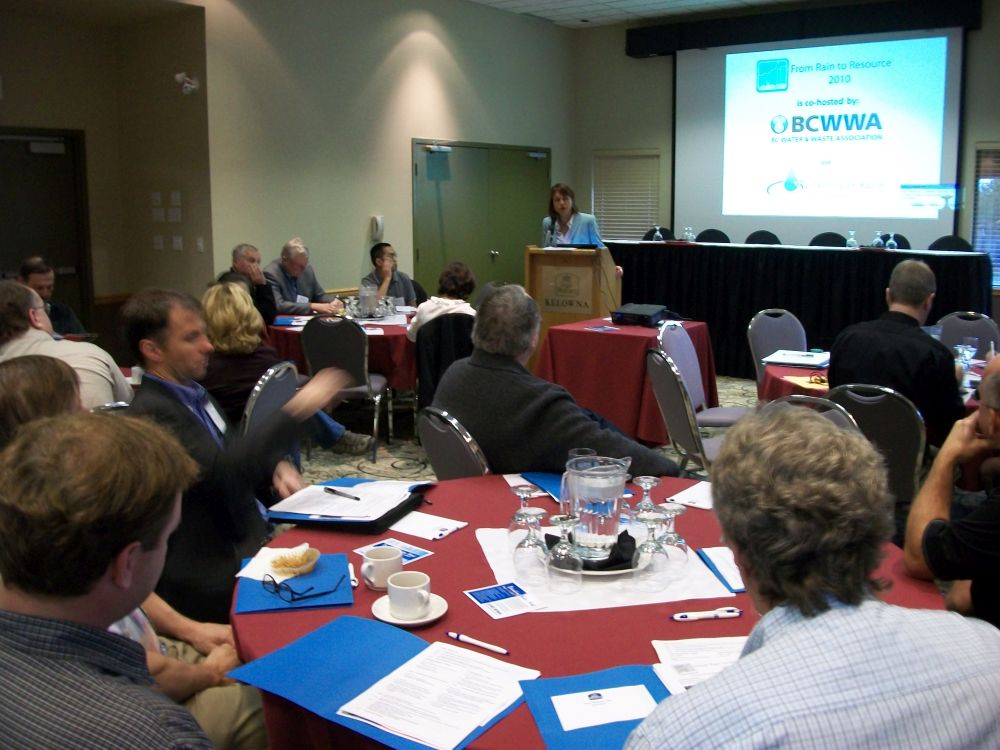OKANAGAN RAIN TO RESOURCE WORKSHOP: Links to downloadable versions of PowerPoint presentations

Rain to Resource Workshop showcased ‘Beyond the Guidebook 2010’ case studies
The 2-day workshop, titled ‘From Rain to Resource: Managing Stormwater in a Changing Climate’ and held in Kelowna in October 2010, was co-hosted by the Okanagan Basin Water Board and the BC Water and Waste Association.
 “Effective rainwater management is a critical tool for adaptation to climate change – a leading policy concern in British Columbia,” stated Anna Warwick Sears, Executive Director of the Okanagan Basin Water Board.
“Effective rainwater management is a critical tool for adaptation to climate change – a leading policy concern in British Columbia,” stated Anna Warwick Sears, Executive Director of the Okanagan Basin Water Board.
“The goal of this workshop was to share positive and innovative developments in rainwater management and to discuss how barriers to change are being overcome in communities in B.C. and beyond.”
Brock Dolman of the California-based WATER Institute was the keynote speaker. He introduced the BC audience to the concept of Conservation Hydrology.
To Learn More:
Download Final Program for complete details.

Convening for Action in British Columbia
According to Ted van der Gulik, Chair of the Water Balanced Model Partnership, the majority of the workshop presentations were delivered by members of the “convening for action” partnership network, and were about case studies that are featured in Beyond the Guidebook 2010, in particular:
- the experiences of these ‘convening for action’ partners: City of Surrey, District of North Vancouver, City of Courtenay, Capital Regional District, Metro Vancouver; and
- these tools and resources: the Water Balance Model, the Topsoil Primer Set.
These “convening for action” case studies were supplemented by several other examples of innovative approaches to rainwater management, including presentations about experience in the BC Interior (e.g. City of Prince George) and within the Capital Region (Douglas Creek Watershed)
Links to Presentations
 Kevin Lagan (City of Courtenay & CAVI – Convening for Action on Vancouver Island): Home Depot Demonstrates Rainwater Management Innovation in the City of Courtenay (2.9MB PDF) — The dramatic change in site characteristics meant rainwater runoff had to be captured to maintain a before development hydrologic regime, if the project was to avoid downstream impacts. To learn more, click here.
Kevin Lagan (City of Courtenay & CAVI – Convening for Action on Vancouver Island): Home Depot Demonstrates Rainwater Management Innovation in the City of Courtenay (2.9MB PDF) — The dramatic change in site characteristics meant rainwater runoff had to be captured to maintain a before development hydrologic regime, if the project was to avoid downstream impacts. To learn more, click here.
 .Jim Dumont (Engineering Applications Authority, Water Balance Model Partnership): East Clayton Green Development in Surrey established BC precedent for implementation of Low Impact Development techniques and facilities (1.6MB PDF) — The clay soils and limited infiltration rates drove innovation in both the calculation methods and the design details to allow the volumetric runoff coefficient to be maintained in both single family and multi-family sites. To learn more, click here.
.Jim Dumont (Engineering Applications Authority, Water Balance Model Partnership): East Clayton Green Development in Surrey established BC precedent for implementation of Low Impact Development techniques and facilities (1.6MB PDF) — The clay soils and limited infiltration rates drove innovation in both the calculation methods and the design details to allow the volumetric runoff coefficient to be maintained in both single family and multi-family sites. To learn more, click here.
 Jody Watson (Capital Regional District): CRD headquarters is the first LEED Gold building in Capital Region — In the Autumn of 2007, the CRD Headquarters Building Phase Two was awarded the Canadian Green Building Council’s prestigious LEED®: Gold designation. To learn more, click here.
Jody Watson (Capital Regional District): CRD headquarters is the first LEED Gold building in Capital Region — In the Autumn of 2007, the CRD Headquarters Building Phase Two was awarded the Canadian Green Building Council’s prestigious LEED®: Gold designation. To learn more, click here.
 Remi Dube (City of Surrey & Water Balance Model Partnership): Topsoil Technical Primer provides framework for implementation, enforcement and long-term viability of absorbent landscape features (11.4MB PDF) — The Technical Primer provides design steps and highlights implementation issues that will help lead to the successful application of an ‘on the ground’ low impact development strategy. To learn more, click here.
Remi Dube (City of Surrey & Water Balance Model Partnership): Topsoil Technical Primer provides framework for implementation, enforcement and long-term viability of absorbent landscape features (11.4MB PDF) — The Technical Primer provides design steps and highlights implementation issues that will help lead to the successful application of an ‘on the ground’ low impact development strategy. To learn more, click here.
 Deborah Carlson (West Coast Environmental Law & Green Infrastructure Partnership): Topsoil Primer connects the dots between rainwater management and drought management (11.8MB PDF) — A policy and legal tool called the ‘Shared Responsibility Matrix’ identifies the actors along with the various instruments that govern their actions. This provides the frame of reference for the Topsoil Primer Set. To learn more, click here.
Deborah Carlson (West Coast Environmental Law & Green Infrastructure Partnership): Topsoil Primer connects the dots between rainwater management and drought management (11.8MB PDF) — A policy and legal tool called the ‘Shared Responsibility Matrix’ identifies the actors along with the various instruments that govern their actions. This provides the frame of reference for the Topsoil Primer Set. To learn more, click here.
 Jim Dumont (Engineering Applications Authority, Water Balance Model Partnership): Water Balance Model facilitates adaptive management approach to implementation of alternative green infrastructure techniques (2.3MB PDF) — The Water Balance Model enables the user to test various methods to establish the easiest and best ways to achieve the most desirable vision of the future for the Site, the Development, or the Watershed. To learn more, click here.
Jim Dumont (Engineering Applications Authority, Water Balance Model Partnership): Water Balance Model facilitates adaptive management approach to implementation of alternative green infrastructure techniques (2.3MB PDF) — The Water Balance Model enables the user to test various methods to establish the easiest and best ways to achieve the most desirable vision of the future for the Site, the Development, or the Watershed. To learn more, click here.
 Ted van der Gulik (Ministry of Agriculture & Lands; Chair of the Water Balance Model Inter-Governmental Partnership): Beyond the Guidebook 2010: Implementing a New Culture for Watershed Protection and Restoration in British Columbia (MB PDF) — A decade ago, British Columbia made a conscious decision to follow an educational rather than prescriptive path to change the way that land is developed and water is used. To learn more, click here.
Ted van der Gulik (Ministry of Agriculture & Lands; Chair of the Water Balance Model Inter-Governmental Partnership): Beyond the Guidebook 2010: Implementing a New Culture for Watershed Protection and Restoration in British Columbia (MB PDF) — A decade ago, British Columbia made a conscious decision to follow an educational rather than prescriptive path to change the way that land is developed and water is used. To learn more, click here.
 Richard Boase (District of North Vancouver; Co-Chair of the Water Balance Model Inter-Governmental Partnership): District of North Vancouver experience in applying the Water Balance Model to develop a watershed restoration vision (5.0MB PDF) — “We saw the Water Balance Model as an important tool that would help us to work within our developed community to restore function and value based on the premise that developed land can contribute to watershed restoration.” To learn more, click here.
Richard Boase (District of North Vancouver; Co-Chair of the Water Balance Model Inter-Governmental Partnership): District of North Vancouver experience in applying the Water Balance Model to develop a watershed restoration vision (5.0MB PDF) — “We saw the Water Balance Model as an important tool that would help us to work within our developed community to restore function and value based on the premise that developed land can contribute to watershed restoration.” To learn more, click here.
 Calvin Sandborn (Legal Director, Environmental Law Clinic at the University of Victoria): Re-Inventing Rainwater Management: A Strategy to Protect Health and Restore Nature in British Columbia’s Capital Region — The report by the Law Clinic documents how ‘green’ rainwater management has now been adopted by engineers, developers, planners and governments across North America. To learn more, click here.
Calvin Sandborn (Legal Director, Environmental Law Clinic at the University of Victoria): Re-Inventing Rainwater Management: A Strategy to Protect Health and Restore Nature in British Columbia’s Capital Region — The report by the Law Clinic documents how ‘green’ rainwater management has now been adopted by engineers, developers, planners and governments across North America. To learn more, click here.
 Kim Stephens (Chair, Metro Vancouver Liquid Waste & Resource Management Reference Panel): From Stormwater Management to RAINwater Management: Implementing a Course Correction in Metro Vancouver (2.4MB PDF) — The policy framework for integrated liquid waste and resource management recommends that Metro Vancouver municipalities re-focus Integrated RAINwater/Stormwater Management Plans (ISMPs) on watershed targets and outcomes. To learn more, click here.
Kim Stephens (Chair, Metro Vancouver Liquid Waste & Resource Management Reference Panel): From Stormwater Management to RAINwater Management: Implementing a Course Correction in Metro Vancouver (2.4MB PDF) — The policy framework for integrated liquid waste and resource management recommends that Metro Vancouver municipalities re-focus Integrated RAINwater/Stormwater Management Plans (ISMPs) on watershed targets and outcomes. To learn more, click here.
Jody Watson (Chair, Bowker Creek Initiative): Bowker Creek Blueprint demonstrates what can be accomplished through a vision, alignment and collaboration — The Bowker Creek Blueprint provides member municipalities, the CRD, the community and other land stewards with information and guidance to restore the watershed and creek corridor over the next 100 years. To learn more, click here.
 Chris Jensen (Ministry of Community & Rural Development; Co-Chair, Vancouver Island Coordinating Team): Bigger Pipes or Greener Communities: A Hydrological Assessment of using Low Impact Development to Mitigate Future Flooding Future Flooding — Climate change significantly raises the risk of rain-generated floods and infrastructure failure. To maintain current levels of service, drainage infrastructure will need to be modified and upgraded. To learn more, click here.
Chris Jensen (Ministry of Community & Rural Development; Co-Chair, Vancouver Island Coordinating Team): Bigger Pipes or Greener Communities: A Hydrological Assessment of using Low Impact Development to Mitigate Future Flooding Future Flooding — Climate change significantly raises the risk of rain-generated floods and infrastructure failure. To maintain current levels of service, drainage infrastructure will need to be modified and upgraded. To learn more, click here.

